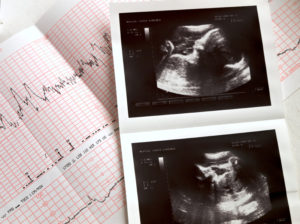My Second Trimester
Week 20
Estimated Reading Time: 7 minutes Wow, you are now halfway through your pregnancy! You may start to feel your baby move as his or her tiny limbs are now nicely defined and freely in motion. Your baby’s first little movements, those flutters, are also known as quickening. This is a very important milestone. Make sure you jot this exciting achievement down and inform your health care team at your next visit. As stated by the Royal College of Obstetricians and Gynaecologists (RCOG), “Maternal perception of fetal movement is one of the first signs of fetal life and is regarded as a manifestation of fetal wellbeing.”
Wow, you are now halfway through your pregnancy! You may start to feel your baby move as his or her tiny limbs are now nicely defined and freely in motion. Your baby’s first little movements, those flutters, are also known as quickening. This is a very important milestone. Make sure you jot this exciting achievement down and inform your health care team at your next visit. As stated by the Royal College of Obstetricians and Gynaecologists (RCOG), “Maternal perception of fetal movement is one of the first signs of fetal life and is regarded as a manifestation of fetal wellbeing.”
Under the vernix, sheets of skin are beginning to build and unify as your baby’s skin is maturing. Tiny nails and subtle wisps of hair are coming into sight. Your baby now weighs about 8 ounces and is 6 inches long, the length of a yellow summer squash.
Your Baby’s 20-Week Ultrasound
 This amazing week will be one of your baby’s most important. After completing your 20-week ultrasound, you will be equipped with vital information. This ultrasound closely examines both your baby’s anatomy and the environment within the uterus.
This amazing week will be one of your baby’s most important. After completing your 20-week ultrasound, you will be equipped with vital information. This ultrasound closely examines both your baby’s anatomy and the environment within the uterus.
All of your baby’s structures will be studied, focusing on your baby’s organs and skeletal system. Congenital Cardiac Heart Disease (CCHD) is the most common congenital disorder in newborns. According to Variation in Prenatal Diagnosis by Michael D. Quartermain, 66% of congenital heart defects are missed during fetal screenings. In other words only 34% of babies will be diagnosed in utero. The Expectant Mother’s Guide to CHD advises you ask your technician or doctor these questions during this ultrasound:
- Do you see all four chambers of the heart?
- Are the heart and other organs in the proper position?
- Do the valves function correctly with normal flow documented by Doppler?
- Are the blood vessels normal in location and size?
- Is the heart muscle squeezing well?
- Do you perform 3-vessel view? Are the cardiovascular structures connected normally?
- Is the heart rate and rhythm normal?
- Are there any signs of circulatory compromise such as abnormal fluid collections?
 Once your baby’s is delivered, make sure you request a simple 5 minute pulse oximetry test to ensure that your baby’s heart is beating flawlessly and oxygenating maximally with no signs of CCHD. The latest research advises waiting for this screening until your baby is 24 hours old or waiting until as close to discharge as possible. Your baby’s right hand or right foot is used during this screening. For further information on CCHD, please go to The National Institute of Health and Wolters Kluwer Health, UpToDate®, a clinical decision support system.
Once your baby’s is delivered, make sure you request a simple 5 minute pulse oximetry test to ensure that your baby’s heart is beating flawlessly and oxygenating maximally with no signs of CCHD. The latest research advises waiting for this screening until your baby is 24 hours old or waiting until as close to discharge as possible. Your baby’s right hand or right foot is used during this screening. For further information on CCHD, please go to The National Institute of Health and Wolters Kluwer Health, UpToDate®, a clinical decision support system.
The umbilical cord and placenta should be carefully assessed for insertion, normal development and position, according to Dr. Collins. Request that EPV be measured at this and every ultrasound (visit Week 7 to learn the importance of keeping up-to-date with placental measurements.)
Dr. Collins encourages every mom to begin a journal at this time blueprinting her baby’s movements. Get to know your baby and start taking the time to jot down when your baby is stirring or slumbering. Daily journaling will enable you to become familiar with the movements of your little one so your baby’s daily routine will become second nature to you. Knowing your baby’s patterns of movement will enable you move easily into Movement Counting, which will begin around Week 28. As we mentioned earlier in Week 8, moms will either have an anterior or posterior placenta, which means that some have their placentas towards the front of the uterus and others towards the back. If your placenta is towards the front (anterior), don’t be alarmed if you are not experiencing or feeling your baby’s movements early in your pregnancy. In fact with this placental position you may not feel as much movement from your baby even in the third trimester when movement counting begins. This is because the placenta serves as a cushion between your tummy and your baby, making it more difficult for you to feel movement and for your health care team to hear your baby’s heartbeat.
 The amniotic fluid volume is evaluated as part of your antepartum fetal surveillance and the sex of your baby is determined at this time. Remember, have fun counting your baby’s ten fingers and ten toes!
The amniotic fluid volume is evaluated as part of your antepartum fetal surveillance and the sex of your baby is determined at this time. Remember, have fun counting your baby’s ten fingers and ten toes!
Discuss all the results of your ultrasound thoroughly with your health care team, addressing any findings or questions you may have. If there is a concern with any aspect of your 20-week ultrasound, they will schedule a more advanced ultrasound and further testing.
Cord Insertion Site to the Placenta: Central, Marginal or Velamentous
 Your medical team will also be able to determine where your baby’s umbilical cord is attached to the placenta at your 20-Week ultrasound. An ideal location is called a central insertion site. This is where the umbilical cord is attached to the very center of the placenta. It provides the healthiest attachment and allows your baby to easily receive oxygen and nutrients when compared to the other two types. The cord can have a marginal insertion site or be velamentous. Both of these conditions are considered abnormal and can cause other complications. It is important to know this attachment early in your pregnancy. If you are diagnosed with a marginal or a velamentous insertion site, your pregnancy will be and should be closely monitored. Your medical team will want to check on your baby often and most likely, you will have more prenatal visits, ultrasounds, Fetal Non Stress Tests (NSTs), and Biophysical Profiles (BPPs). These abnormal attachments can cause problems, and do create enough of a concern for more frequent monitoring.
Your medical team will also be able to determine where your baby’s umbilical cord is attached to the placenta at your 20-Week ultrasound. An ideal location is called a central insertion site. This is where the umbilical cord is attached to the very center of the placenta. It provides the healthiest attachment and allows your baby to easily receive oxygen and nutrients when compared to the other two types. The cord can have a marginal insertion site or be velamentous. Both of these conditions are considered abnormal and can cause other complications. It is important to know this attachment early in your pregnancy. If you are diagnosed with a marginal or a velamentous insertion site, your pregnancy will be and should be closely monitored. Your medical team will want to check on your baby often and most likely, you will have more prenatal visits, ultrasounds, Fetal Non Stress Tests (NSTs), and Biophysical Profiles (BPPs). These abnormal attachments can cause problems, and do create enough of a concern for more frequent monitoring.
Preterm Labor
 At this visit, ask your health care team to explain the signs and signals of preterm labor. Always inform your health care team of any contractions that you experience.
At this visit, ask your health care team to explain the signs and signals of preterm labor. Always inform your health care team of any contractions that you experience.
“What is preterm labor, when does it begin and how will you know if you are having it?” Preterm labor occurs before your 37th gestational week. You are probably familiar with Braxton-Hicks Contractions which are erratic, feeble contractions varying in duration and strength and usually end when you relax, drink water, change your level of activity or alter your position. Braxton-Hicks contractions are considered “false” labor contractions.
You will need to be concerned about contractions which are different from Braxton-Hicks. A few indications that you may be experiencing preterm labor are contractions occurring at recurring intervals that are regular, contractions that may or may not become stronger, contractions including low backache, spasms, twinges or any other discomfort and contractions altering your vaginal secretions, for example, bleeding or spotting or water being emitted or oozing from your vagina.
According to the Mayo Clinic:
“Signs and symptoms of preterm labor include:
- Regular or frequent sensations of abdominal tightening (contractions)
- Constant low, dull backache
- A sensation of pelvic or lower abdominal pressure
- Mild abdominal cramps
- Vaginal spotting or light bleeding
- Preterm rupture of membranes — in a gush or a continuous trickle of fluid after the membrane around the baby breaks or tears
- A change in type of vaginal discharge — watery, mucus-like or bloody
If you experience these signs or symptoms or you’re concerned about what you’re feeling, contact your health care provider right away. Don’t worry about mistaking false labor for the real thing. Everyone will be pleased if it’s a false alarm.”
If you experience any of these symptoms, call your health care team and go to Labor and Delivery (L&D) for further evaluation. For further information on the signs, symptoms and management of preterm labor please visit the Mayo Clinic or the March of Dimes.
Register At Your Favorite Stores
 Now is the time to begin making lists, refreshing your wardrobe and planning on your baby’s necessities. You will now know whether to shop for pink or blue!
Now is the time to begin making lists, refreshing your wardrobe and planning on your baby’s necessities. You will now know whether to shop for pink or blue!